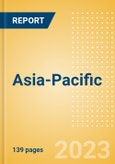Total revenue in the Asia-Pacific profit sector reached $1.5 trillion in 2022, showing gradual decline with a compound annual growth rate (CAGR) of 2.2% from 2017-22.. The economic slowdown in the wake of the COVID-19 pandemic brought the sector’s value down significantly in this period. During 2017-22, the travel channel registered a steep decline in value sales, falling at a negative CAGR of 11.8%, due to limited consumer footfall amid COVID-19 restrictions and challenging economic conditions. QSR led the profit sector in terms of number of transactions in 2022. Despite challenging macroeconomic conditions across the region, the channel’s number of transactions declined only slightly over 2017-22.
The report includes -
- Overview of Asia-Pacific's macro-economic landscape: Detailed analysis of current macro-economic factors and their impact on the Asia-Pacific foodservice market including GDP per capita, consumer price index, population growth, and annual household income distribution.
- Growth dynamics: In-depth data and forecasts of key channels (QSR, FSR, coffee & tea shop, and pub, club & bar) within the Asia-Pacific foodservice market, including the value of the market, number of transactions, number of outlets and average transaction price.
- Customer segmentation: Identify the most important demographic groups, buying habits, and motivations that drive out-of-home meal occasions among segments of the Asia-Pacific population.
- Key players: Overview of market leaders within the four major channels including business descriptions and number of outlets.
Scope
- The QSR channel was relatively more resilient during 2017-22 than all other profit sector channels. While other channels declined in value terms, QSR achieved a value CAGR of 0.4% in this period. In 2022, takeouts made up 61.2% of the QSR channel’s value. Their share more than doubled during 2017-22, rising from 29.1% in 2017 to 61.2% in 2022. Takeouts generated a CAGR of 16.5% in this period.
- Full-service restaurant (FSR) was the largest channel in Asia-Pacific in 2022. In the region, the channel accounted for 52.3% of the profit sector’s value in 2022. China was the largest market in the region, with a channel value share of 70.7%.
- The coffee & tea shop’s channel’s value declined at a negative CAGR of 1% during 2017-22. China was the largest market in 2022, with a value share of 32.1%. The number of outlets generated a CAGR of 6.1% over 2017-22.
- The pub, club & bar channel’s value declined at a negative CAGR of 5.5% during 2017-22. India was the largest market in 2022, with a value share of 38.1%. The number of transactions decreased at a negative CAGR of 2.5% in the 2017-22 period, while the number of outlets fell at a negative CAGR of 1.5%.
Reasons to Buy
- Specific forecasts of the foodservice market over the next five years (2022-27) will give readers the ability to make informed business decisions through identifying emerging/declining markets.
- Consumer segmentation detailing the desires of known consumers among all major foodservice channels (QSR, FSR, coffee & tea shop, and pub, club & bar) will allow readers understand the wants and needs of their target demographics.
Table of Contents
- Introduction
- Report Guide
- Executive Summary
- Foodservice Industry Trends
- Profit Sector Metrics
- Overview
- Key Metric Highlights
- Value Growth by Channel
- Outlets and Transactions Growth by Channel
- Operator Buying Volumes and Growth by Channel
- Outlet-Type and Owner Type Growth Dynamics
- Profit Sector by Channel
- Quick-Service Restaurant (QSR)
- Summary & Key Points
- Metrics
- Key Players
- Who?
- Why?
- What?
- Where?
- What Next?
- Full-Service Restaurant (FSR)
- Summary & Key Points
- Metrics
- Key Players
- Who?
- Why?
- What?
- Where?
- What Next?
- Coffee & Tea Shop
- Summary & Key Points
- Metrics
- Key Players
- Who?
- Why?
- What?
- Where?
- What Next?
- Pub, Club & Bar
- Summary & Key Points
- Metrics
- Key Players
- Who?
- Why?
- What?
- Where?
- What Next?
- Cost Sector Metrics
- Cost Operator Trends - Historic and Future Growth
- Data and Channel Share Breakdown
- Country Deep-Dive
- Appendix
Companies Mentioned (Partial List)
A selection of companies mentioned in this report includes, but is not limited to:
- McDonald's
- Yum! Brands
- Fujian Wallace Food
- Restaurant Brand International
- Domino’s Pizza
- Zensho Holdings
- Skylark Holdings
- Akindo Sushiro
- Starbucks
- Shenzhen Meixixi Catering Management
- Zhengzhou Liang’an Enterprise
- Shenzhen Pindao Food & Beverage Management
- Luckin Coffee
- Country Style Cooking Restaurant Chain
- Inner Mongolia Xiao Wei Yang Chained Food Service








